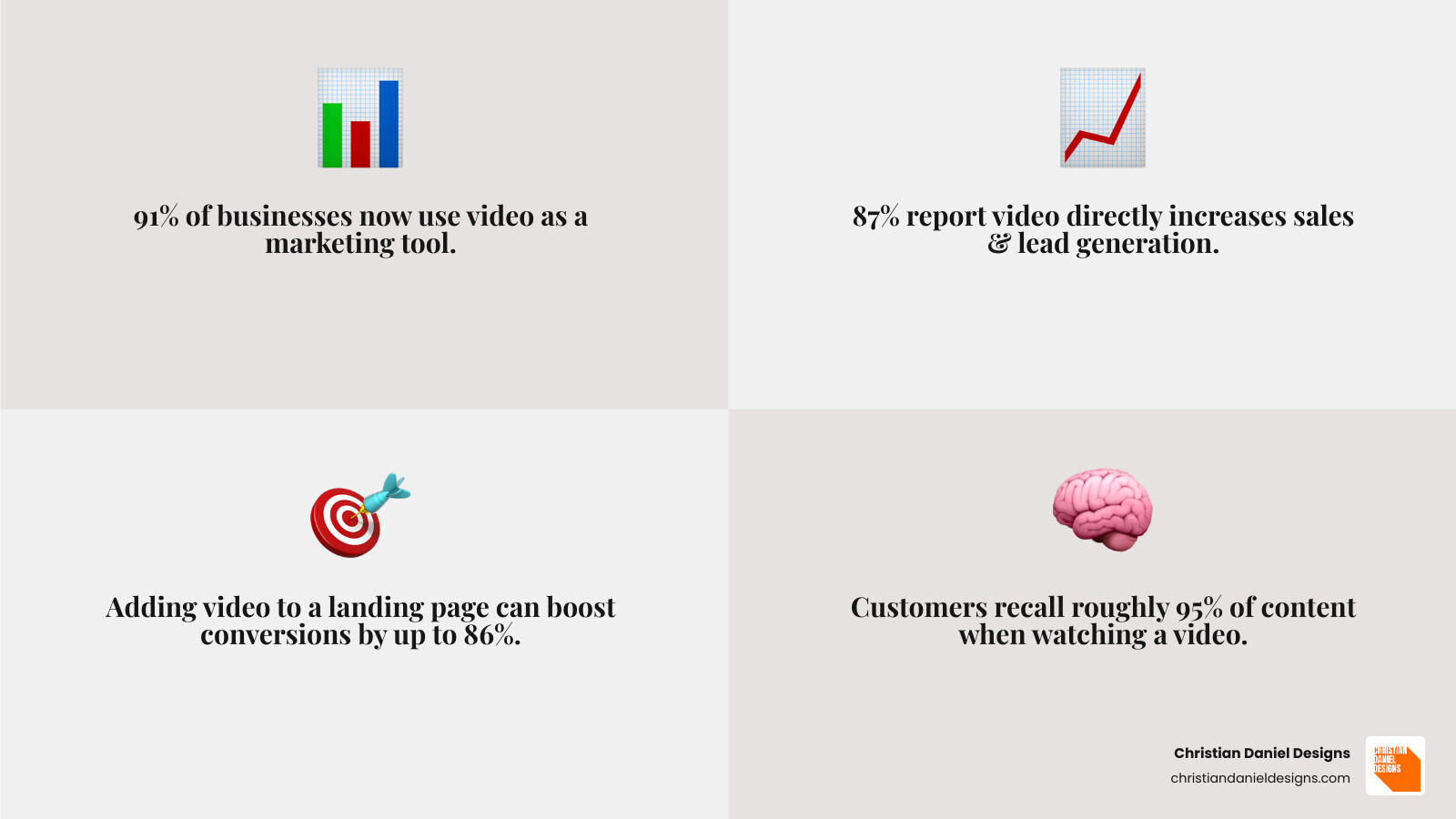Why Video Content for Business is Essential for Modern Growth
Video content for business isn’t optional anymore—it’s essential. The data is clear: 91% of businesses now use video as a marketing tool, and 87% report that it directly increases sales and lead generation.
Quick Answer: Creating an Effective Video Content Strategy
- Define your goals – What do you want video to achieve? (brand awareness, leads, sales)
- Know your audience – Who are you speaking to and what do they care about?
- Choose your video types – Explainer videos, product demos, testimonials, or social content.
- Plan your distribution – Website, social media, email campaigns, or paid ads.
- Measure and optimize – Track views, engagement, conversions, and adjust accordingly.
Video grabs attention, builds trust, boosts search rankings, and turns viewers into customers. Whether you’re running a restaurant, a hotel, or a creative business, video helps you stand out.
However, creating video that works requires a strategy. You need the right video type for your goal, a clear message for your audience, and a distribution plan to get it seen. The good news? You don’t need a massive budget to get started.
I’m Christian Daniel, and I’ve spent over two decades producing award-winning video content for business clients including The Plaza Hotel and Park Hyatt Chicago, delivering campaigns that drive measurable results like $62,000 in direct bookings from a single video. Through Christian Daniel Designs, I help hospitality and creative businesses transform their digital presence with video strategies that convert.

Why Video is Non-Negotiable for Business Growth in 2025
If your business isn’t using video in 2025, you’re leaving money on the table. Video content for business has moved from “nice to have” to “absolutely essential,” delivering measurable improvements in engagement, conversions, brand recognition, and customer trust.
The data is compelling: 87% of marketers report that video directly increases sales, and another 87% see it boosting lead generation. Why? Because video cuts through the noise. Research suggests it creates powerful emotional responses that drive action. The impact is tangible: adding a video to a landing page can increase conversion rates by up to 86%.
If you’re ready to harness this power strategically, check out my guide on Strategic Video Marketing.
Boost Engagement and Brand Recall
Customers recall roughly 95% of a message when they watch it in a video, compared to only 10% when reading text. This superior recall translates directly into engagement. Social media videos generate up to 1200% more shares than text and images combined, giving small businesses incredible organic reach.
Platforms like Facebook, Instagram, and TikTok prioritize video in their algorithms, giving your content more visibility. Video also builds trust, as 89% of consumers want to see more videos from brands they follow. Through storytelling, you can craft memorable narratives that transform casual viewers into loyal customers.
Improve Your SEO and Drive Traffic
Video also provides a significant SEO boost. When visitors watch a video on your site, they stay longer. This increased dwell time and lower bounce rate signals to Google that your content is valuable, improving your search rankings.
Furthermore, people use YouTube as a search engine. By optimizing your video titles, descriptions, and tags with relevant keywords, your content can appear in both Google and YouTube search results, doubling your visibility.
Quality videos also earn valuable backlinks from other sites, further boosting your domain authority. In today’s digital landscape, video isn’t just about looking professional—it’s about being found, remembered, and chosen.
A Step-by-Step Guide to Creating High-Impact Video Content for Business
Creating video content for business can feel overwhelming, but you don’t need a Hollywood budget to make videos that work. What you need is a clear process. A well-planned video shot on a smartphone will always outperform a flashy, expensive video that misses the mark.

This roadmap will walk you through every step, from strategy to measuring results.
Step 1: Define Your Strategy for Video Content for Business
Skipping strategy is like building a house without a blueprint. Start by getting clear on who you’re talking to. What are their pain points and where do they hang out online?
Next, define your specific goals. Instead of “more customers,” aim for “generate 50 new email subscribers” or “increase website traffic by 20%.” Your Key Performance Indicators (KPIs) flow from these goals: track views for awareness, click-through rates for leads, and conversion rates for sales.
Finally, establish your content pillars—three to five core themes that align with your brand—and set a realistic budget. Authenticity often trumps production value, so you can start small.
For a deeper dive, check out our Small Business Video Content Guide.
Step 2: Choose the Right Video Type for Your Goal
The type of video you create should flow from your goals.
- Explainer videos: Perfect for breaking down complex ideas. A high percentage of consumers have watched one to learn about a product.
- Product demos: Show your product in action solving real problems.
- Customer testimonials: Provide powerful social proof and build trust faster than anything else.
- How-to videos: Position you as an expert by providing genuine value.
- Short-form content: Reels, TikToks, and Shorts are perfect for capturing attention and driving engagement on mobile.
- Live video: Creates real-time connection and community through Q&As or behind-the-scenes content.
- Company culture videos: Humanize your brand and attract top talent.
We also use cutting-edge techniques like AI Product Videos to create stunning visual explanations for complex products.
Step 3: Plan, Script, and Produce Your Video
This is where your idea becomes reality.

- Scriptwriting: A good script is your foundation. Keep it conversational and include a clear call to action. A bad script leads to a bad video, no matter the budget.
- Storyboarding: A simple visual roadmap (stick figures are fine!) helps you plan your shots before you start filming.
- Equipment: Start with your smartphone. The most important investment is an external microphone—good audio is critical. A tripod will ensure stable shots.
- Filming: Use good lighting (natural light is best) and eliminate background noise. If you don’t have original footage, stock images and footage can also create compelling visuals.
- Editing: This is where you trim footage, add music, and insert graphics. For a professional finish on important projects, our Video Editing Services for Marketing Campaigns ensure your video looks polished and performs.
- Call to Action (CTA): Every video needs one. Tell viewers exactly what to do next: visit your site, sign up, or make a purchase.
Step 4: Distribute and Promote Your Video Content
A great video is useless if no one sees it. A smart distribution strategy is key.
- Your Website: Embed videos on landing pages, product pages, and blog posts to increase dwell time and boost conversions.
- Social Media: Tailor content for each platform. YouTube is a search engine for tutorials and long-form content. Instagram thrives on visual Reels and Stories. TikTok is for short, entertaining, trend-based videos. LinkedIn is for professional, B2B content.
- Email Marketing: Including the word “video” in your subject line can increase open rates by 19% and click-through rates by 65%.
- Paid Advertising: Use social and YouTube ads to target specific demographics and expand your reach.
- SEO Optimization: On YouTube, use keyword-rich titles, descriptions, and tags to help people find your content.
We specialize in creating and optimizing content for Instagram, TikTok, and YouTube. Learn more about our Reels, TikToks and YouTube Videos services.
Step 5: Measure Your ROI and Optimize
Measuring performance is how you learn what works. Don’t skip this step.
- Views: Your basic reach.
- Watch Time and Retention Rate: Shows how engaging your content is. Are people watching to the end?
- Engagement Rate: Likes, comments, and shares signal that your message resonates.
- Click-Through Rate (CTR): Measures how many people clicked your CTA link.
- Conversion Rate: The ultimate metric. Are viewers taking the desired action (e.g., making a purchase)? 84% of people say a brand video has convinced them to buy.
Use Google Analytics and social media insights to monitor these metrics. Let the data guide your future video strategy.
For a comprehensive look at measuring financial returns, explore our guide on How to Measure Video Marketing ROI.
Overcoming Common Video Marketing Challenges for Small Businesses
The idea of creating video content for business can feel intimidating, especially for a small operation. Common concerns like “It’s too expensive” or “I don’t have time” are valid, but they are more manageable than you think. You no longer need a film crew or a massive budget to create content that drives real results.
Overcoming Budget and Skill Gaps in Video Content for Business
The biggest myth about video marketing is that it has to be expensive. Your smartphone is a powerful production studio. Paired with good lighting and clear audio, you have 90% of what you need. An external microphone is the single best investment you can make, often costing less than $50.
To manage your time, think in batches. Dedicate a few hours once a month to film multiple videos. Plan your content ahead and repurpose everything. A single three-minute video can be turned into several short social clips, quotes for stories, and even audio for a podcast.
For everyday social content, a DIY approach is perfect—authenticity is key. For cornerstone assets like your brand story or a major product launch, investing in professional help pays dividends and can deliver a substantial return.
Our guide on Video Marketing Strategies for Small Businesses breaks down how to maximize impact with limited resources.
The Do’s and Don’ts of Business Video
After two decades in this field, I’ve learned what works. Here are the key rules to follow.
| Do’s | Don’ts |
|---|---|
| Be authentic: Show your real personality. People connect with people, not corporate facades. | Aim for virality: Focus on creating consistent, valuable content for your target audience, not chasing a one-hit wonder. |
| Add captions: Most mobile video is watched without sound. Captions ensure your message lands and improve accessibility. | Forget audio quality: Poor audio will ruin even the most beautiful video. Invest in a decent microphone. It’s non-negotiable. |
| Have a clear CTA: Tell viewers exactly what to do next. A video without a CTA is a missed opportunity. | Copy competitors: Inspiration is fine, but imitation is not. Develop your unique voice to stand out. |
| Optimize for mobile: Most video is watched on smartphones. Ensure your videos are formatted correctly and text is readable. | Use it only once: Repurpose and redistribute your content across all channels to maximize its reach and lifecycle. |
| Educate or entertain: Provide real value. Your content should serve your audience, not just your promotional goals. | Neglect measurement: Track your KPIs to understand what’s working and what isn’t. Use data to refine your strategy. |
Authenticity often trumps production value. When you show up genuinely and consistently, you build relationships that translate into loyal customers and measurable growth.
The Future of Video Marketing: Trends to Watch in 2025 and Beyond
The landscape of video content for business is always evolving. As we look to 2025, several innovations are reshaping how businesses connect with audiences.
Artificial intelligence is making video production accessible to everyone. AI-powered editing tools can polish footage, suggest cuts, and even generate videos from text prompts, allowing small businesses to create compelling content without huge budgets. Our 3D Product Video AI Ultimate Guide explores how this tech is revolutionizing product marketing.
Personalization is also advancing. AI can now adapt a video’s message based on viewer data like past purchases or demographics, creating hyper-targeted content that drives higher conversions.
Shoppable videos are blurring the line between content and commerce. Viewers can click on products within a video to make an instant purchase, creating a frictionless path to sale.
Interactive content, such as clickable menus, polls, and branching narratives, transforms passive viewing into active participation, creating more memorable brand experiences.
Short-form video remains the dominant force. Platforms like TikTok and Instagram Reels have trained audiences to expect quick, high-impact content. The challenge is making every second count.
Above all, authenticity continues to trump perfection. Audiences crave genuine, relatable content. Raw footage with honest storytelling often outperforms slick productions, which is great news for small businesses. Focus on being real, helpful, and yourself.
Frequently Asked Questions about Video Content for Business
We understand you might still have questions about integrating video content for business into your marketing. Here are answers to the most common ones I hear.
How much should a small business budget for video marketing?
You can start with a zero-dollar budget. Your smartphone, natural light, and a clear message are enough to create effective content for social media.
When you’re ready to invest, costs can range from a few hundred dollars for freelance editing to several thousand for a fully produced video ($1,500-$5,000+ per finished minute).
The key is to start small with a clear goal. Create one high-quality video, measure its performance, and scale your efforts based on what you learn.
What is the ideal length for a marketing video?
It depends on the platform and your goal.
- Social Media (Reels, TikTok): Keep it short, ideally 15-60 seconds.
- Website (Explainers, Demos): You have more leeway, typically 2-5 minutes, as visitors are actively seeking information.
The most important rule is to capture attention in the first 3-5 seconds. If you don’t hook viewers immediately, the rest of the video’s length is irrelevant.
Can I create effective videos with just my smartphone?
Yes, absolutely. Some of the most engaging content is shot on a smartphone. The key isn’t the camera, but these three things:
- Good Audio: This is non-negotiable. An inexpensive external microphone is the best investment you can make.
- Stable Shots: Use a simple tripod to eliminate shaky footage.
- Good Lighting: Film near a window for free, high-quality natural light.
On social media, authenticity and a clear message often matter more than high production value. Focus on genuine storytelling, and you’ll connect with your audience.
Conclusion
Video content for business is no longer a future trend—it’s how your customers want to connect with you right now. They watch videos to learn, decide, and buy. If you’re not in that space, you’re leaving money on the table.
You now have a roadmap to create videos that work, from strategy and production to distribution and measurement. The best part? You can start today, exactly where you are. You don’t need a Hollywood budget; you need authenticity, value, and consistency.
The challenges of time and budget are manageable with today’s tools. A smartphone, a clear strategy, and a willingness to start are all it takes to make a meaningful impact on your brand.
For businesses in New York City, Queens, Jersey City, or Hoboken looking for expert guidance to create polished, professional short-form videos that get noticed, Christian Daniel Designs offers specialized short-form video editing services. Let’s work together to create video content that doesn’t just look good—it gets results.





